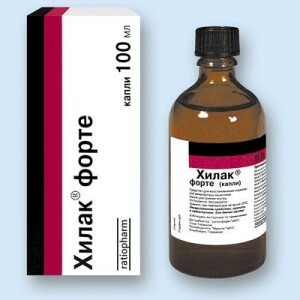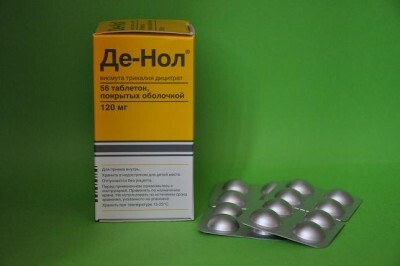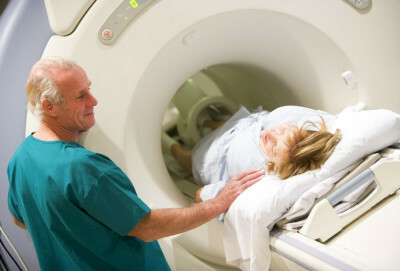1 Diagnosis of the disease
For the reliable diagnosis of dysbiosis, the patient's stool is taken. The analysis of feces allows to establish the fact of imbalance of bacteria and its degree. Based on the degree of imbalance, preparations are prescribed for the intestinal dysbiosis of a particular group.
The bacterial composition of the intestinal microflora is divided into useful bacteria and conditionally pathogenic. The use of almost all antibiotic drugs causes imbalance of microflora in the intestine - dysbiosis.
Imbalance of the microflora manifests itself as follows:
- stool disorder, expressed in diarrhea or constipation;
- nausea and vomiting accompanied by abdominal pain;
- a noticeable weight loss;
- allergic reactions are possible, especially in children.

We recommend that you familiarize yourself with the
- Diet for intestinal dysbiosis in adults
- When is the GFD of the stomach prescribed and is there a contraindication?
- How do colonoscopy of the intestine and for what?
- Effective remedy for gastritis and stomach ulcer
2 Directions in the treatment of
What can be done to treat dysbacteriosis? In order to normalize the imbalance of the intestinal microflora, complex measures are always applied, that is, the doctor prescribes treatment in several directions at once.
First, the cause of dysbacteriosis is eliminated. The reason may be the usual use of antibiotics to treat other diseases, poisoning - dysentery or salmonellosis, stomach diseases such as peptic ulcer, pancreatitis, cholecystitis. The cause may be a mental disorder caused by severe stress.

To understand the cause and determine the drugs for treatment can only an experienced specialist - gastroenterologist. Causes of dysbiosis can be eliminated with drugs that restore bowel function, anti-inflammatory drugs or drugs designed to replace enzymes produced in the intestine.
The second direction takes into account the severity of dysbacteriosis and is aimed at normalizing the patient's condition. The method of achieving this goal are specially designed diets, with the observance of which the digestion of the patient gradually comes back to normal.
-
 IMPORTANT TO KNOW! Gastritis? Ulcer? To have a stomach ulcer not turned into cancer, drink a glass. ..Read the article & gt; & gt;
IMPORTANT TO KNOW! Gastritis? Ulcer? To have a stomach ulcer not turned into cancer, drink a glass. ..Read the article & gt; & gt;
The third direction includes the use of antibacterial tablets, bacterial eaters - bacteriophages, antiseptic agents for the stomach. Prebiotics or probiotics, which restore the processes of bacterial formation, are appointed depending on the degree of imbalance.
The fourth component of the integrated approach to the treatment of intestinal dysbacteriosis is the measures aimed at restoring the body's defenses. These measures are based on the use of natural immunomodulating agents - this is important in the treatment of children. In some cases, synthetic tablets can be used.
3 Therapeutic methods
Treatment of dysbacteriosis is prescribed depending on two main factors: the degree of imbalance and age of the patient. The degree of bacterial disorder is determined even at the stage of diagnosis by the result of the analysis of stool. At the same stage, the cause that led to the disorder, for example, the use of antibiotics, is determined.
Treatment in all cases involves the use of a complex of drugs against dysbiosis, compliance with a prescribed gastroenterologist special diet, the use of ancillary drugs. The totality of all these measures forms a scheme of treatment, which is determined individually for each and depends on the patient's condition and the results of laboratory tests performed in the diagnosis.
-
 Gastroenterologist. IMPORTANT: "I beg you, if you began to worry about abdominal pain, heartburn, nausea, do not in any way do gases. .."Read more & gt; & gt;
Gastroenterologist. IMPORTANT: "I beg you, if you began to worry about abdominal pain, heartburn, nausea, do not in any way do gases. .."Read more & gt; & gt;
The degree of imbalance of microflora is divided into 3 main groups. Each degree is characterized by its indications for the treatment of patients suffering from dysbacteriosis. The degree of dysbiosis can increase in direct proportion to the duration of antibiotic use.

In addition, the methods of treating dysbacteriosis depend, as already mentioned, on the patient's age. There are 4 age groups: children under 1 year, children over 1 year old, adults up to 50 years and adults after 50 years.
For example, for the treatment of 1 degree of dysbiosis in all age groups, the use of such drugs as prebiotics is indicated.2 degree of dysbacteriosis is treated with probiotics. At 3 degrees of intestinal dysbacteriosis, along with probiotics, several other active drugs are used, usually antibacterial tablets, of course, bacteriophages and intestinal antiseptics.
In all cases and for any degree of diagnosis of dysbiosis, treatment is reinforced by the use of additional drugs: specially developed vitamin complexes and enterosorbents. In case of treatment of children, special complexes of vitamins are used. In addition, at all stages of the disease and at any age during treatment, an individual diet should be observed. In medicine, such a diet is called functional nutrition.
TIP FROM THE MAIN GASTROENTEROLOGIST
Korotov SV: "I can recommend only one remedy for the rapid treatment of Ulcer and Gastritis, which is now recommended by the Ministry of Health. .." Read testimonials & gt; & gt;
The drugs used to treat dysbacteriosis at any stage will not bring any benefit without special functional nutrition: this is the best remedy for dysbiosis. After all some forms of a dysbacteriosis, especially at the first stages, it is possible to cure, applying exclusively functional food.
If the dysbacteriosis takes a more severe stage, functional nutrition is supplemented with the use of probiotics and prebiotics. Treatment of children requires a special approach.
Balanced dietary nutrition, in addition to proteins, fats and carbohydrates, should contain a sufficient number of vitamins and trace elements. With such nutrition, the patient should drink at least 2 liters of fluid every day. For children, of course, quantitative adjustments are made. The diet should be observed as strictly as possible.
During the main treatment, the diet is subject to the necessary correction, so all treatment should be done only under the supervision of the doctor.
4 Prebiotics for microflora
Preparations, called prebiotics, help to balance the intestinal microflora. Probiotics have the same properties, but they are much more pronounced. The composition of these drugs includes both the bacteria themselves and their by-products.

Prebiotics are prescribed for mild degrees of dysbacteriosis and for children. These drugs only stimulate the production of the necessary bacteria by the intestines, helping the body to solve the problem itself. Prebiotics contain the very useful bacteria and nutrient medium for their successful growth and reproduction.
Such medications for intestinal dysbacteriosis are absolutely safe. Along with the development of beneficial bacteria, called obligate microflora, prebiotics interfere with the development of opportunistic bacteria. These drugs are unpretentious in storage and use, they include the following medicinal groups: disaccharides and lactic acids.
Lactulose and lactitol can be cited as an example of disaccharides. List of drugs, which include disaccharides: Normase, Dufalac, Poslabin, Prelax, Goodluck, Laktusan, Export.
The drug Hilak-forte is lactic acid. Substances that are part of the medicines are often contained in its natural form in the following products: corn and chicory root, onions and garlic, in many lactic acid products. Such products are very useful for dysbiosis, especially for children.
5 Powerful probiotics
Probiotics are positioned as more powerful drugs than prebiotics, and are used to treat complex forms of dysbiosis in stages 2 and 3.Most drugs for treating dysbacteriosis are compatible with antibiotics.
Live microorganisms, which are part of probiotics, quickly establish a bacterial balance of the intestine. By quantitative and qualitative composition of drugs are divided into several categories: multicomponent, monocomponent, combined, recombinant, synbiotic and antagonists.
- Polycomponent probiotics, as the name implies, have several representatives of living cultures of microorganisms: first of all, lactobacilli, then bifidum and colibacteria. Representatives of polycomponent probiotics are such effective tools as Linex and inexpensive Bifiform and Bifikol. Treatment with these powerful drugs lasts an average of only 2 weeks. Lineks, for example, can be used directly when taking antibiotics.
- The composition of probiotics of a monocomponent group is represented by only one species of bacteria. The names of the drugs of this group directly derive from the name of the bacteria themselves: Bifidumbacterin, Lactobacterin and Colibacterin. These drugs are narrowly focused, usually applied after a course of antibiotics and can only benefit after a comprehensive examination of the gastroenterologist. Monocomponent drugs are considered more suitable for the treatment of children.
- Combined preparations based on probiotics consist of whole groups of bacteria and strains. Such preparations, together with the main components, have in their composition nutrient media that stimulate the development of certain bacteria and immunomodulating substances. Such probiotics have a complex effect and have an excellent therapeutic effect. Under conditions of application of these preparations multiplication of useful bacteria is considerably accelerated. An example of such a probiotic is the preparation Rioflora-immuno.
- There are preparations for intestinal dysbacteriosis, which are developed using genetic engineering techniques. Such probiotics include cloned genes. Such genes help control the production of interferon. Preparations with such properties are called recombinant probiotics. A bright representative is Bifiliz. These drugs are not used to treat children.
- A group of synbiotics is characterized by a parallel use in the treatment of both prebiotics and probiotics. Due to this approach to treatment, it is possible to obtain a very stable result, which is very important in the treatment of dysbacteriosis. Synbiotic probiotics are, for example, Bifidobac and Laminolact. However, the duration of treatment with such drugs is increased to 3 weeks.
- A group of probiotics called "antagonists" is characterized by a good ability to suppress bacteria that make up a conditionally pathogenic microflora. They do not form bacteria for the intestines, but only interfere with their formation. The drugs representing this group - Enterol and Bactisubtil - perfectly normalize the stool and belong to the class of antidiarrheal drugs. Use of such drugs for more than 1 week is considered unacceptable. In addition, probiotics-antagonists are suitable for the treatment of children only in extreme cases.
Dysbacteriosis of the 3rd degree, if there are corresponding indications of the doctors, is cured with the use of additional antibacterial agents. Such remedies rudely destroy bad bacteria, creating conditions for a balanced development of the bacterial flora of the intestine.
- 1 Diagnosis of the disease
- 2 Directions in the treatment of
- 3 disease Therapeutic methods
- 4 Prebiotics for microflora
- 5 Power probiotics
The number of bacteria in the human body is enormous. If the balance of useful and harmful bacteria is disturbed, dysbacteriosis arises. Preparations for dysbacteriosis are available in various dosage forms: suppositories, tablets, capsules, ampoules. They differ in their actions: bacteriophages, prebiotics, probiotics, antibacterial drugs. These medications from dysbacteriosis are often supplemented with the use of intestinal antiseptics, immunomodulators, vitamins and enterosorbents.
Do you have gastritis?
GALINA SAVINA: "How easy is it to cure gastritis at home for 1 month. A proven method - write down a recipe. ..!"Read more & gt; & gt;
In addition, drugs for the treatment of dysbacteriosis, being the main means of systemic therapy, can be supplemented by various diets. After all, proper nutrition for patients suffering from dysbacteriosis is very important. Specialists - doctors-gastroenterologists - can easily diagnose and prescribe a course of treatment.



